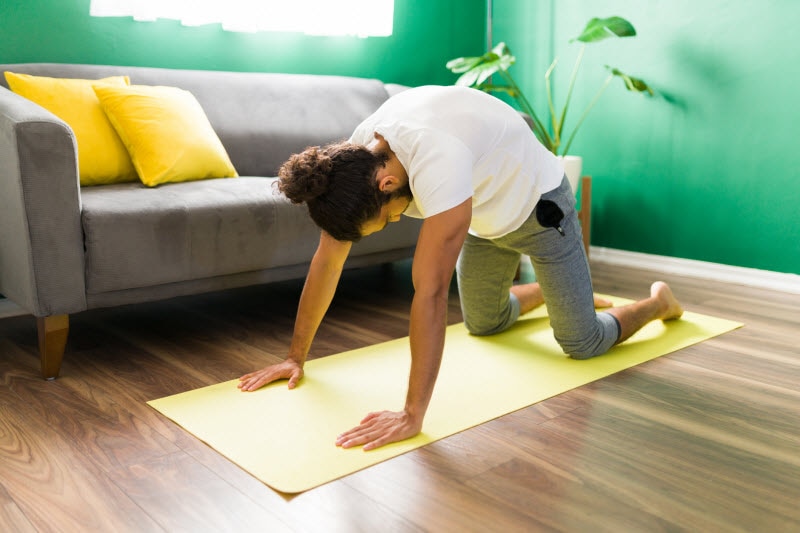The last thing you want to do when you’re under the weather is exercise — and for good reason.
Your body is hard at work fighting whatever illness you have. It doesn’t need the additional stress of a workout. Generally, medical experts suggest you don’t exercise if you have a fever, the flu or symptoms below your neck, including chest congestion.

But a little movement — think gentle yoga — could provide relief if you have an ordinary cold or barely-there fever (as in: under 100 degrees Fahrenheit). We’re talking slow, simple stretches and comfortable breath-work.
A 2020 review of 14 studies from North and South America and Europe published from 1990 through 2018 suggests moderate exercise might ease the intensity and number of symptoms from acute respiratory illness. The review’s authors noted larger trials of better quality would offer more robust evidence though.
Yoga when you’re sick: 4 stretches for relief
In the meantime, here are 4 yoga exercises that can provide relief while you’re sick. As long as you’re not taxing your body, movement is fine — and then you can be the judge of whether it improves your condition.
Basic guidelines
Use how you feel as a marker: If all you want to do is sleep, then sleep, and don’t force yourself to do these or any other practices. If you feel worse while doing any of these exercises, stop.
1 Neck rolls with lengthened breaths
If it feels okay to do so, lie on your back; lying down requires less effort than sitting or standing. Otherwise, sit with your back supported. Inhale, expanding your abdomen and lower ribs to the count of three (or as close to three as possible). Hold your breath for as long as feels comfortable, if at all. Exhale for longer than you inhaled, as you turn your head to one side, keeping your chest broad and your shoulders relaxed. Inhale your head back to center, again for a count up to three. Hold your breath for as long as feels comfortable, then exhale for longer than you inhaled, as you turn your head to the other side. Repeat as many times as feels comfortable.
Why it works
Modulated breathing regulates your nervous system and improves your mood. Throughout the days and nights you’re under the weather, remind yourself to take smooth, steady breaths. You don’t need to hold your breath, but be sure to inhale and exhale completely (it’s worth noticing how often you otherwise take shallow breaths).
2 Seated or standing cat-cow
Place your palms on your front thighs, while seated or standing. If you’re standing, bend your legs enough to get your hands mid-thigh, with your feet at a comfortable stance and your knees tracking the same direction as your toes. As you inhale, press your chest forward and up, lifting your chin and drawing your shoulder blades together. Keep your shoulders down. As you exhale, spread your shoulder blades apart and drop your chin a little. Repeat as many times as feels comfortable.
Why it works
Cat-cow opens your front and back torso, while gently massaging your organs. Focus especially on opening your front torso (chest and front shoulders). The shoulders, chest and neck tend to tighten from coughing, and cat counters that.
3 Side-body straddle stretch
Sit on a padded surface on the ground. Straddle your legs at whatever degree feels appropriate. Your pelvis should be barely tipped forward (anteverted). In other words, if your pelvis were a bowl filled with water, the water would trickle down the front of the bowl. If your back rounds (this happens when your pelvis is retroverted; water would spill from the back), sit on a book, block, cushion or the corner of a chair to get your pelvis in the correct position and your spine in its natural alignment.
As you inhale, lengthen your spine and lift your right arm, keeping your left hand down on your left leg or a nearby surface for stability. As you exhale, lean to the left. Soften your right elbow, if you’d like. Hold for as long as feels comfortable, focusing on expansion in your right side and back ribs as you inhale. Repeat the process with your left arm as you lean to the right.
Why it works
Side torso stretches can help you breathe more easily by encouraging you to focus on inhaling through expansion of neglected parts of the rib cage: the sides and back (take an automatic inhale and notice which part of your ribs expands — probably not the sides and back). Stretching your legs, which house your biggest muscles, feels good, particularly if you haven’t been active because you’ve been sick.
4 Legs up the wall
Take a seat one to two feet from a wall. Gently lie back with your torso perpendicular to the wall. Place your heels on the wall. Adjust your distance from the wall so that you feel a gentle stretch on the back of your legs. Drop your arms to your sides wherever feels comfortable. Take slow, steady breaths. Hold for as long as you’d like.
Why it works
If your head or nose are stuffy, they might feel worse lying down. That said, unless you’re going to sleep upright, you’ll need to lie down at some point to go to bed. Just before bed is a good time to do this pose, which offers a helpful and soothing runway for nighttime sleep because it is calming.
Wellness writer Mitra Malek has been a yoga instructor since 2006. She encourages students to do what feels right for their body, including when they’re under the weather.
Featured Products



The post Simple Yoga Stretches to Help Relieve Cold and Flu Symptoms first appeared on The Upside by Vitacost.com.

